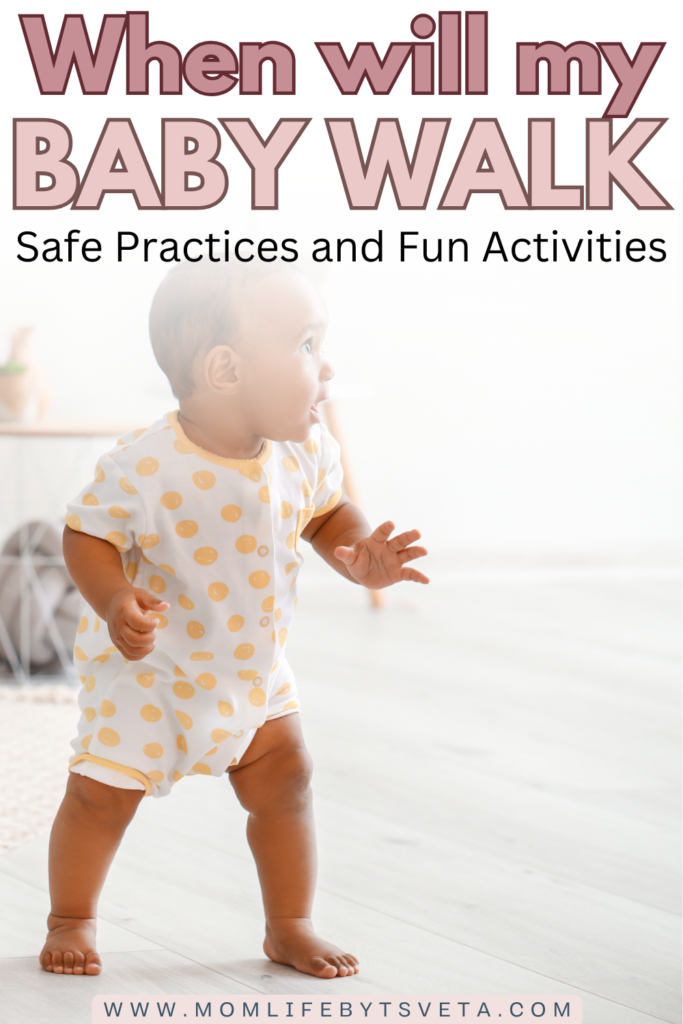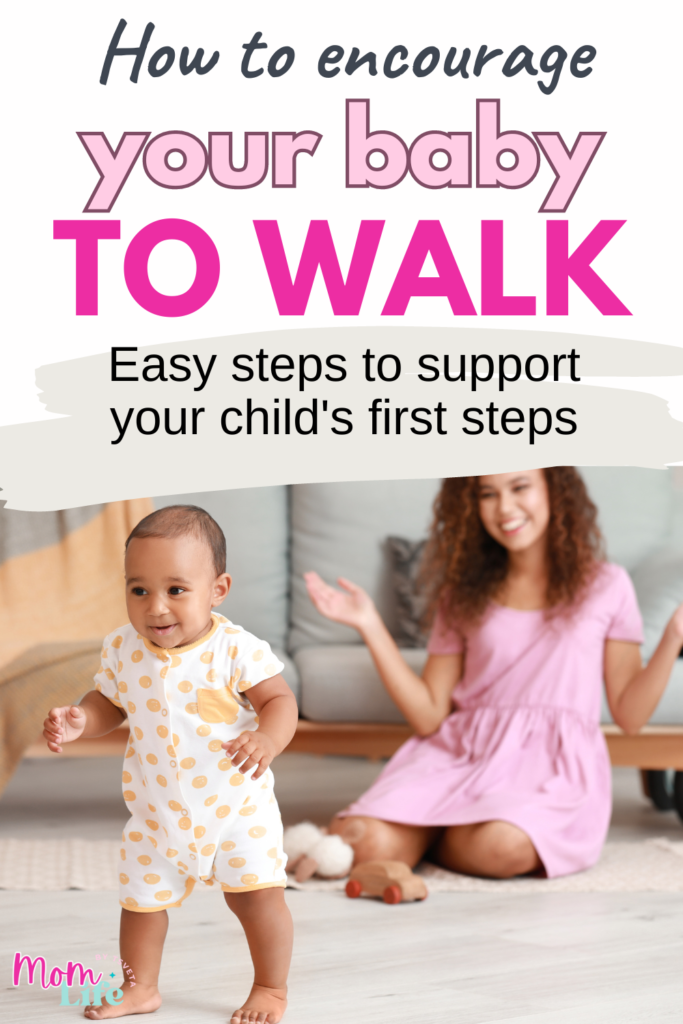Let’s talk about one of your little one’s big milestones: walking! It’s more than just a physical achievement; it’s a leap towards independence. Typically, babies start walking between 9 to 18 months, but remember, every child is different.
As parents, our role is crucial. We need to cheer, support, and encourage our kids as they take these first steps. Whether your baby is just pulling themselves up or tentatively stepping, your encouragement makes all the difference. Let’s help them navigate this exciting stage—one tiny, wobbly step at a time!
This blog post contains affiliate links. If you click on these links and make a purchase, I may receive a small commission at no extra cost to you. This helps support our blog and allows us to continue to create helpful content for parents like you. Thank you for your support!
Table of Contents

Recognizing Readiness for Walking
Wondering if your baby is ready to start walking? Here’s what to look out for:
First up, neck and head control. It’s a game-changer because if your little one can hold their head steady, they’re more likely to balance while standing and walking.
Then, there’s sitting and crawling. If your baby can sit without your help and crawls around, they’re gearing up for the next big thing: standing up.
Watch for when they pull up to stand. It’s super exciting when babies pull themselves up using the couch or coffee table—it means they’re getting ready to move and groove.
Cruising is next. If you see your baby moving along furniture while standing, that’s a big hint they’re testing their walking skills.
And don’t forget about their interest in moving. A baby who’s curious about reaching objects that are just out of reach is showing signs they might be ready to start walking soon.
Each of these milestones is a step closer to walking. Keep encouraging them—it’s a thrilling time for your baby’s development!
Preparing for Walking
Alright, let’s get your little one ready for walking!
Strengthening Muscles: To kick things off, you can help build those tiny leg muscles. Try some gentle leg exercises—like stretching and bending their legs while they’re on their back. Also, regular belly time is fantastic; it not only strengthens their legs but also their core and arms.
Balance Practice: Next up, balance is key. Hold your baby in a standing position, using the support of a playpen or just your hands. This helps them feel the motions of standing and gets them used to bearing weight on their legs.
Each of these activities is all about preparing your baby for walking, giving them the strength and confidence they need to take those adorable first steps!

Creating a Safe Learning Environment
Let’s make sure your space is ready for a baby on the move!
Baby-Proofing: First things first, safety is key. Start by securing any heavy furniture that could tip over. Clear the floors of anything sharp or hazardous that could hurt your little explorer. Think about padding sharp corners too — anything to make the area baby-friendly.
Appropriate Footwear: When it comes to those tiny feet, going barefoot indoors can actually help your baby with balance and coordination. It lets them feel the floor and get a grip! If you’re stepping outside or want some protection indoors, look for shoes that are soft, flexible, and have non-slip soles.
Creating this safe, comfy environment is crucial. It lets your baby practice walking without any worries, which means peace of mind for you too!
Using Baby Walking Aids Wisely
You need to pick the right tools to help your baby walk!
Choosing Walking Toys: When it comes to walking aids, push walkers are fantastic. They offer just enough support without doing all the work for your little one. This means your baby still uses their natural walking muscles and skills, which is super important.
Caution with Walkers: A quick note on traditional baby walkers — the kind babies sit in. Many pediatricians give these a thumbs down because they can be risky. There’s a higher chance of accidents, like tumbling down stairs or reaching things they shouldn’t. Plus, they might not help with proper walking development.
Choosing the right aids can really support your baby’s journey in learning to walk, just make sure they’re safe and effective!

Encouraging Walking Through Play
Interactive Games: One awesome way to encourage those first steps is to turn it into a game. Try placing your baby’s favorite toys a few steps away. This little “treasure hunt” motivates them to move towards the toys. It’s a simple trick, but it works wonders in making walking exciting!
Using Visual and Audio Cues: Babies love bright colors and fun sounds! Use musical toys or colorful markers to grab their attention. Place these a little out of reach during playtime, and watch as your baby is motivated to move towards these enticing objects.
Incorporating play like this not only makes walking practice enjoyable but also keeps your baby engaged and eager to explore on their feet! Additionally, if you’re looking for more ideas on how to engage in age-appropriate play, you might want to check out our guide on how to play with your 1 year old. This guide offers a variety of activities that not only keep your child entertained but also help develop crucial motor skills and coordination.
Monitoring Progress and Setting Milestones
Let’s keep an eye on those big moments!
Recognizing Milestones: Watch for key signs that your baby is getting ready to walk. These include pulling themselves up to stand, standing without any help, and, of course, those magical first few steps. Each of these milestones is a huge deal in your baby’s walking journey!
Keeping a Progress Journal: It’s a great idea to keep a journal or a video log of these milestones. Not only is it super rewarding to look back on, but it also helps you keep track of your baby’s development. You can jot down notes or film those precious moments—whatever works best for you!
Tracking progress like this really puts the whole walking adventure into perspective. Plus, it’s an amazing way to cherish these memories forever!

Addressing Common Concerns
Got some concerns? Let’s address them!
Bow Legged Walking: It’s pretty common to see babies wobble around with bowed legs. No worries, though! Most of the time, this is just part of how they grow and it usually sorts itself out as they get older. By the time they’re toddling around more confidently, you’ll notice their legs straightening out.
Tiptoe Walking: If your little one is often walking on their tiptoes, it’s generally nothing to stress about in the early years. However, if they’re still tip-toeing beyond the toddler years, it might be good to chat with your pediatrician. They can check if there’s any underlying issue or just reassure you that your kiddo is doing fine.
Addressing these common concerns helps you stay informed and keep things in perspective as your baby explores walking!
When to Seek Professional Advice
If you notice that your baby isn’t walking by 18 months or if their walking pattern seems unusual, it might be time to talk to someone. This could be your pediatrician or even a pediatric physical therapist. They can help figure out if everything is on track or if a little extra help might be needed.
It’s always better to check in if you’re unsure. Getting a professional’s insight can offer peace of mind and ensure your baby is on the right path with their walking journey!
Conclusion: Patience and Support
We’re almost there!
Encouragement: Remember, each baby’s journey to walking is unique. It takes patience and lots of emotional support. Celebrate every little success along the way and keep encouraging your little one with lots of love and cheers.
Engagement: Got any stories or questions about your baby’s walking adventures? Drop them in the comments below! Sharing experiences can help us all learn and create a supportive community for all the parents out there.
Thanks for joining in on this journey to baby walking. Here’s to many happy steps ahead for you and your little one!




[…] Walking independently and possibly uttering their first words are monumental achievements in your baby’s […]